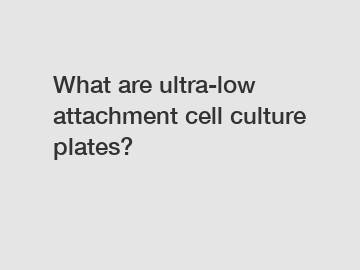What are ultra-low attachment cell culture plates?
What are ultra-low attachment cell culture plates?
Ultra-low attachment cell culture plates are specialized laboratory equipment designed to facilitate the growth and maintenance of cells in a suspension or non-adherent state. These plates are made from special materials that prevent cells from attaching to the surface, enabling them to grow as three-dimensional aggregates or spheroids.
The adoption of 3D cell culture models has gained significant attention in recent years as they more accurately mimic the in vivo environment. Traditional methods involve culturing cells on conventional culture plates, where they grow as monolayers attached to the surface. However, this two-dimensional growth often lacks the complexity and cellular interactions found in natural tissues and can lead to biased results during drug discovery and tissue engineering studies.

The development of ultra-low attachment cell culture plates addresses these limitations by allowing cells to grow freely in suspension, mimicking their natural state more closely. The plates are designed with a hydrophilic surface coated with a proprietary polymer that prevents cell adhesion. This non-adhesive surface reduces shear stress on the cells and enables the formation of spheroids, multicellular aggregates, or organoids that better represent the complexity of tissues.
In terms of significance, the use of ultra-low attachment cell culture plates has several advantages. Firstly, they promote the formation of cell aggregates, which enables enhanced cell-cell interactions and cell-extracellular matrix interactions, leading to more physiologically relevant responses. This is particularly important in cancer research, where 3D cultures can better mimic tumor growth and response to therapy.
Additionally, these plates allow for the growth of specialized cell types that are challenging to culture in traditional systems. Cells such as stem cells, primary cells, and certain cancer cell lines prefer non-adherent conditions for optimal growth and functionality. Using ultra-low attachment plates can improve the success rate of culturing these cells and maintain their desired characteristics.
Moreover, the ability to culture cells in a suspension state using ultra-low attachment plates has important implications for drug discovery and development. By enabling the growth of 3D cell models, these plates can improve the accuracy of drug screening assays, leading to more reliable preclinical data. This can potentially reduce the number of failed drug candidates, saving both time and resources in the drug development process.
In conclusion, ultra-low attachment cell culture plates provide a valuable tool for researchers in various fields, allowing them to better mimic the natural environment and behavior of cells. Their ability to promote the formation of multicellular aggregates and maintain cell functionality has significant implications for disease modeling, drug screening, and tissue engineering. As the demand for more physiologically relevant cell models continues to grow, the use of ultra-low attachment cell culture plates is likely to become increasingly prevalent in the scientific community.
The company is the world’s best glass bottom petri dish, erlenmeyer flask used in laboratory, micro-carrier packed beds supplier. We are your one-stop shop for all needs. Our staff are highly-specialized and will help you find the product you need.


